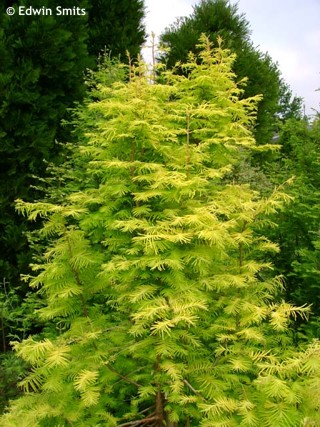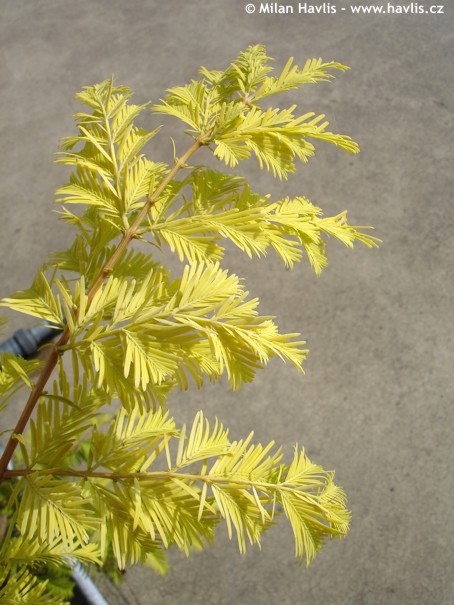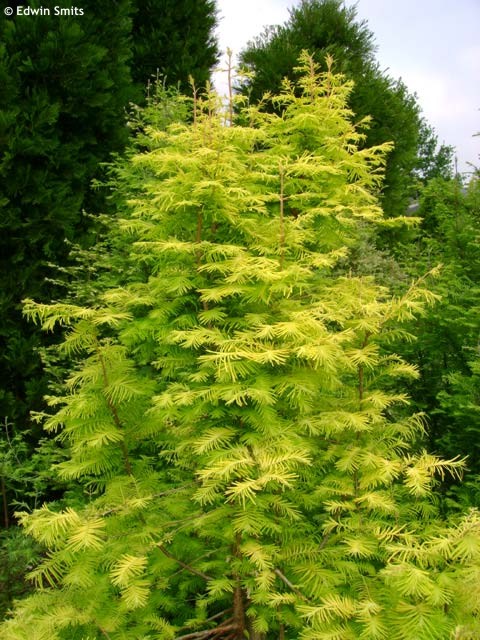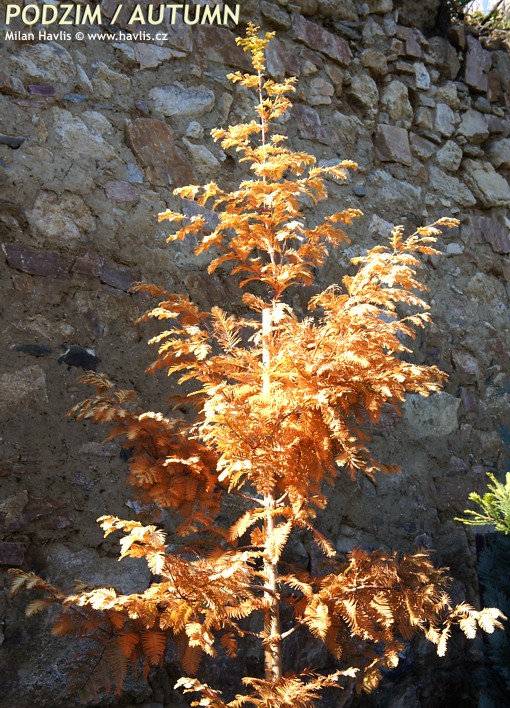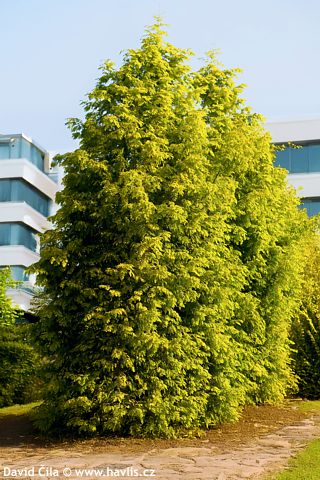Metasequoia glyptostroboides 'Golden Oji' GOLD RUSH (syn. 'Ogon') dawn redwood
size/type
medium-sized tree,medium-sized tree
usual height
3-7m
usual width
2-3m
leaves
deciduous conifer
colour of leaves
flowers
insignificant or non-blooming
location
full sun
soil type
any (acidic to alkaline)
soil moisture requirements
tolerates (but does not demand) wet ground
USDA zone (lowest)
4 (down to -34°C)
winter protection
for zone 5+6

for zone 7

categorized
Metasequoia
There’s a horticultural legend from the mid-1940s that goes something like this: For centuries, metasequoia had been believed to be extinct in the wild and buried only in fossils just like trilobites. It wasn't until 1941 that a live specimen was found in China, which was immediately subjected to botanical research, enthusiastically propagated, and subsequently introduced to the world as newly resurrected creatures of our prehistorical past. Who wouldn't want a tree from the dinosaur era in their own yard! However. I bet you know what it’s like when it comes to legends – every talking head adds something to it. By the year 2000 the story got so muddled, with so many people feasting on it, not only those from the media, but also those from academic circles who wanted to elevate their own prestige, that botanist Jinshuang Ma of the Brooklyn Botanic Garden decided to trace the true footsteps. In 2002 and consequently in 2003 he published two papers on the subject where he explained the following:In 1943, the Chinese botanist Zhan Wang collected the first seeds and a few branches from a single specimen he found. Unaware of their importance and of the fact that he had mistakenly named the plant as Glyptostrobus pensilis, he sent them to Nanjing University's Professor W.C. Cheng. There, they identified his mistake and, amazed by his discovery, in the spring of 1946, they sent one of their students, C.T. Hwa to examine the site in the so-called Metasequoia Valley to collect more seeds. Plenty more seeds, I have to say; he collected several kilograms (!) of them and when we consider that he had to walk on foot a large part of the journey, his merits are directly proportional to the weight of his backpack. Upon his return, the seeds were distributed from the university to 76 addresses around the world – from botanical gardens and schools to private collectors. The combination of the plant and its legend kicked off a horticultural sensation and huge media interest and caused a lot of speculations and academic disputes among experts.
The post-war cooling down of relations between communist China and the capitalist West ended almost all exchange for some 30 years, including botanical exchange. Hence no more seeds from China. Luckily, many growers in other countries, having had to do with what they had, naturally tried vegetative propagation, too. They were delighted to discover how easily metasequoia was propagated by cuttings, and moreover that it was resistant to almost all diseases and pests. Thanks to them, this tree is now readily available in every good nursery, and, thanks to the plant’s variability, there are quite a few attractive varieties (29 registered to date) suitable even for smaller gardens.
Description of the plant:
GOLD RUSH metasequoia is considered one of the finest yellow-leaved dawn redwood cultivars of the 20th century and is still used as a parent for new breeding. It was created by Masaru Shibata by irradiating seeds at the Kameyama Research Station in Mie, Japan, in 1974, and was named simply Ogon (Japanese for gold 黄金). Subsequently, it reached the USA, where it was launched by Larry Stanley from the Stanley & Sons Nursery in Oregon, who also gave it a new trade name GOLD RUSH. In Europe, the cultivar was introduced by Dutch nurseryman Pieter Zwijnenburg in 1993. It was obvious that the cultivar was popular, and more success was just around the corner, so a year later, the Japanese company New Oji Paper Co Ltd, representing the original breeder, applied for patent protection, which they obtained, and patent no. PP9346 was granted in 1995, however, under the name Golden Oji. This was somewhat unfortunate because a Cupressocyparis of the same name already existed, and moreover, no one knew this metasequoia by that name. Anyway, everyone seems to have stuck with the US trade name GOLD RUSH ever after.Metasequoia GOLD RUSH bears soft, flat, deciduous needles that are bright yellow in spring, mature to chartreuse in summer, and turn to honey to reddish-copper colour in autumn before they fall. It grows about 25-35 cm per year into a symmetrical, pyramidal shape. In full sun, it forms nice, regular branch layers and, in consistently moist to slightly waterlogged soil, offers luxurious foliage that hides the trunk during the season. However, it is worth waiting for the trunk to be visible in winter. It is bright mahogany red and conspicuously fibrous, which stands out especially in winter.
Dawn redwood is closely related to bald cypress (taxodium distichum) and requires very similar conditions: humus-rich, deep, moist soil, some sources even recommend boggy soil. We have been growing it here in partly water-logged location and it has been doing great. Grow it in full sun only. Pruning is possible in spring in order to maintain smaller size or to achieve a denser habit especially in young trees. But avoid over-pruning – do not prune more than 30% of the canopy to prevent stressing the tree. It is fully hardy to min. -29 °C (USDA zone 5).
Last update 21-12-2008; 16-01-2017; 20-02-2025
QUICK PRICE OVERVIEW
CURRENTLY SOLD OUT
WANT TO TRY A SIMILAR PLANT?












